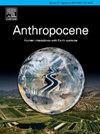巴塔哥尼亚晚全新世湖泊沉积物显示南极洲没有主要的黑碳来源
IF 3.3
2区 地球科学
Q2 ENVIRONMENTAL SCIENCES
引用次数: 0
摘要
生物质和化石燃料燃烧产生的黑碳是气候系统中重要的气溶胶。了解其历史变化对于限制当前人类活动和野火对大气的影响至关重要。巴塔哥尼亚以前被认为是13世纪晚期在南极半岛北部的冰芯中观测到的黑碳增加的主要来源,但在南极大陆的冰芯中没有观测到。在这里,我们利用对两个巴塔哥尼亚湖沉积物岩心中过去两千年的耐火黑碳(rBC)的高分辨率测量重建了该地区的黑碳趋势,并将结果与该地区其他火灾活动记录进行了比较。我们的新rBC重建,与来自同一地点的宏观木炭数据以及区域木炭数据一致,表明在过去的2000年里,巴塔哥尼亚地区的火灾活动很低,从13世纪开始,没有重大的、长期的和系统的增加,大大超出了这些记录中早期检测到的值。这些地点持续的低rBC沉积表明,巴塔哥尼亚的排放并没有导致观测到的13世纪晚期南极半岛冰芯中rBC的增加。此外,整个工业时期红细胞沉积量低表明,巴塔哥尼亚红细胞记录主要反映了区域生物质燃烧的排放,而不是化石燃料燃烧。本文章由计算机程序翻译,如有差异,请以英文原文为准。
Patagonia's Late Holocene lake sediments reveal no major black carbon sources for Antarctica
Black carbon from biomass and fossil fuel burning is an important aerosol in the climate system. Understanding its historical variation is crucial to constrain current anthropogenic and wildfire impacts on the atmosphere. Patagonia was proposed previously as a major source region for the late 13th century black carbon increase observed in an ice core from the northern Antarctic Peninsula but not in continental Antarctic ice cores. Here, we reconstruct regional black carbon trends using high-resolution measurements of refractory black carbon (rBC) in two Patagonian lake-sediment cores spanning the last two millennia and compare the results with other records of fire activity in the region. Our new rBC reconstruction, which is consistent with macroscopic charcoal data from the same sites as well as regional charcoal data, indicates low fire activity in this region of Patagonia over the past 2000 years, with no major, long-lasting and systematic increase from the 13th century onwards that goes significantly beyond values detected earlier in these records. The consistently low rBC deposition at these sites suggests that Patagonian emissions did not contribute to the observed late 13th century rBC increases in ice cores from the Antarctic Peninsula. Moreover, the low amounts of rBC deposition throughout the Industrial Period suggests that Patagonian rBC records primarily reflect emissions from regional biomass burning and not fossil fuel combustion.
求助全文
通过发布文献求助,成功后即可免费获取论文全文。
去求助
来源期刊

Anthropocene
Earth and Planetary Sciences-Earth and Planetary Sciences (miscellaneous)
CiteScore
6.30
自引率
0.00%
发文量
27
审稿时长
102 days
期刊介绍:
Anthropocene is an interdisciplinary journal that publishes peer-reviewed works addressing the nature, scale, and extent of interactions that people have with Earth processes and systems. The scope of the journal includes the significance of human activities in altering Earth’s landscapes, oceans, the atmosphere, cryosphere, and ecosystems over a range of time and space scales - from global phenomena over geologic eras to single isolated events - including the linkages, couplings, and feedbacks among physical, chemical, and biological components of Earth systems. The journal also addresses how such alterations can have profound effects on, and implications for, human society. As the scale and pace of human interactions with Earth systems have intensified in recent decades, understanding human-induced alterations in the past and present is critical to our ability to anticipate, mitigate, and adapt to changes in the future. The journal aims to provide a venue to focus research findings, discussions, and debates toward advancing predictive understanding of human interactions with Earth systems - one of the grand challenges of our time.
 求助内容:
求助内容: 应助结果提醒方式:
应助结果提醒方式:


